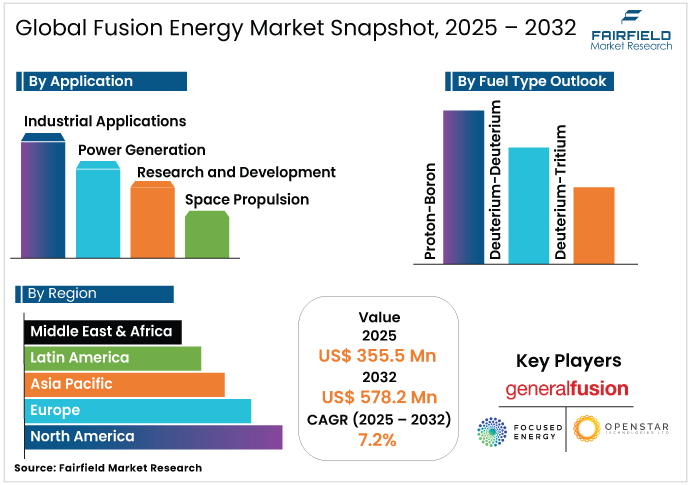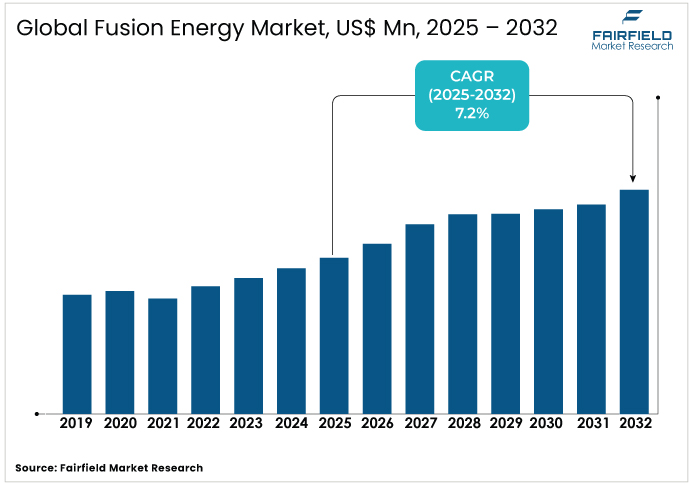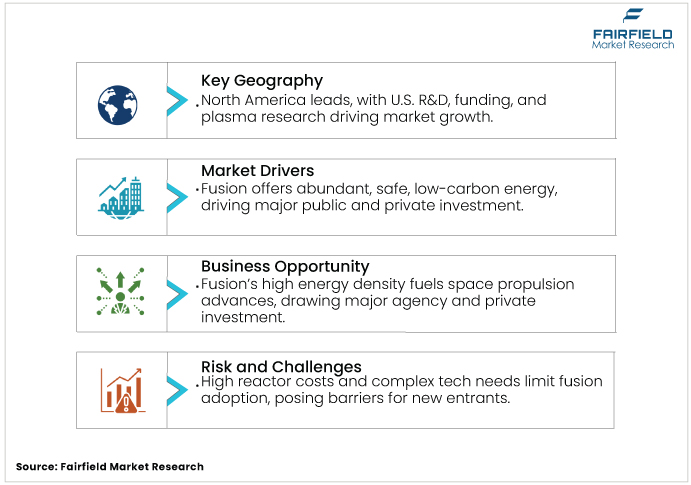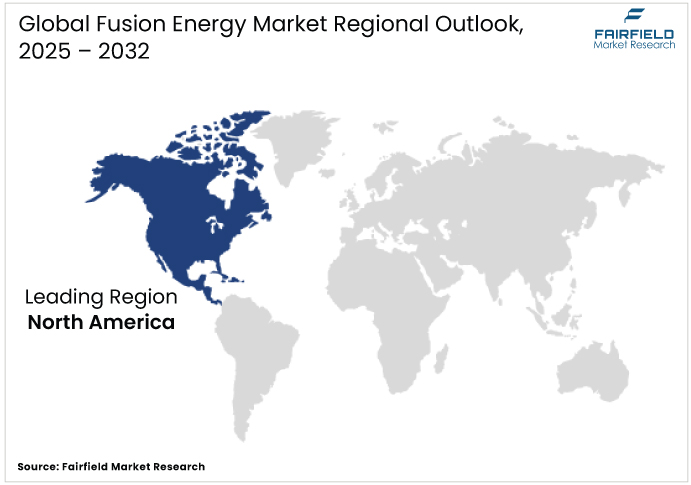Global Fusion Energy Market Growth and Industry Forecast
- The global fusion energy market is projected to be worth US$ 355.5 Mn in 2025 and is expected to reach US$ 578.2 Mn by 2032.
- The market is set to grow at a CAGR of 7.2% during the forecast period from 2025 to 2032.

Fusion Energy Market Summary: Key Insights & Trends
- Power Generation accounts for the largest share in the global fusion energy market, supported by major fusion energy projects.
- Space Propulsion is the fastest-growing application, driven by fusion’s potential for deep-space missions and compact reactor innovations.
- Magnetic Confinement Fusion leads the global market with over 52% share in 2024, due to maturity and strong research backing.
- Deuterium-Deuterium Fuel Type is emerging as a key opportunity, offering sustainability advantages over tritium-based reactions.
- Asia Pacific holds nearly a 44% share in the global market for fusion energy, driven by rapid R&D growth in China, Japan, and South Korea.
- Global fusion energy investments exceeded US$7.1 billion in 2024, with public-private partnerships accelerating commercialization timelines.
A Look Back and a Look Forward - Comparative Analysis
The fusion energy sector witnessed early-stage development between 2019 and 2024, propelled by growing research investments and notable progress in plasma control and advanced materials. While the COVID-19 pandemic caused temporary setbacks to experimental initiatives and disrupted supply chains, continued government backing, especially across North America and Europe. Several private firms attracted substantial venture capital, and global collaborations contributed to technological milestones. Although commercialization remained distant, private sector engagement significantly expanded during this period.
Looking ahead, the fusion energy market is expected to maintain steady growth through 2032. Innovations in superconducting magnet technology and artificial intelligence applications in plasma regulation are anticipated to fast-track prototype development. Pilot projects are likely to demonstrate sustained operation capabilities, setting the stage for future commercialization. The sector will see leadership from established Western economies, while increasing R&D efforts in countries such as China and Japan position Asia Pacific as a key emerging region.
Key Growth Drivers
- Rising Global Demand for Clean Energy Fuels Fusion Technology Adoption
Fusion energy produces no greenhouse gas emissions and minimal radioactive waste, making it an attractive alternative to fossil fuels. According to the International Energy Agency, global energy demand is expected to rise by 30% by 2040, necessitating low-carbon solutions. Fusion’s potential to deliver abundant, safe energy equivalent to 4 million times the energy from fossil fuels, which drives significant investments. In 2024, over 65% of fusion funding came from public sources, with the U.S. Department of Energy and Euratom allocating multi-year budgets for pilot plants.
- Cutting-Edge Technological Innovations Accelerate Fusion Energy Development
Innovation in magnetic confinement and inertial confinement technologies are key drivers. High-temperature superconducting magnets, as used by Commonwealth Fusion Systems, enable compact reactor designs, reducing costs and improving efficiency. AI and machine learning enhance plasma stability, with companies such as TAE Technologies leveraging AI for real-time adjustments. The National Ignition Facility’s 2022 breakthrough in inertial confinement demonstrated net energy gain, boosting investor confidence. These advancements are critical as the market transitions from R&D to pilot plants, with technology readiness levels (TRLs) reaching 4–7.
- Growing Investments and Strategic Collaborations Drive Fusion Energy Momentum
The fusion energy market benefits from escalating public and private investments. In 2024, global fusion investments exceeded US$ 7.1 billion, with US$ 900 million added in a single year. Strategic partnerships, such as Tokamak Energy’s collaboration with Sumitomo Corporation, accelerate commercialization. Government-backed projects such as ITER, supported by the EU, U.S., China, and others, alongside private ventures such as Helion Energy’s agreement with Microsoft, underscore the market’s potential. These collaborations foster innovation and resource sharing, positioning fusion as a cornerstone of future energy systems.

Key Growth Barriers
- High Capital Investment Requirements Limit Fusion Energy Market Accessibility
The fusion energy market faces significant challenges due to the high capital costs of building fusion reactors. Constructing facilities requires billions of dollars, with initial investments for fuel production, plasma containment, and maintenance being substantial. The complexity of achieving and sustaining fusion reactions at extreme temperatures (over 100 million°C) demands advanced materials and infrastructure, deterring some investors. While costs are expected to decrease post-commercialization, the current financial barrier limits market entry for smaller players, slowing widespread adoption.
- Persistent Technical Barriers Hinder Fusion Energy Commercialization Progress
Despite progress, the market grapples with technical hurdles in achieving sustained fusion reactions. Maintaining plasma stability at high temperatures and managing tritium supply chains remain complex. Deuterium-tritium reactions, while efficient, produce neutrons that damage reactor materials, requiring costly refractory solutions. Most technologies are at TRLs 4–7, indicating a gap between prototypes and commercial viability. These challenges delay timelines, with commercial deployment not expected until the early 2030s, impacting market growth.
Fusion Energy Market Trends and Opportunities
- Government Support and Policies Strengthen Growth Outlook for Fusion Energy
The fusion energy industry is poised for growth due to increasing government support for decarbonization and energy security. In 2024, the International Atomic Energy Agency noted that over 65% of fusion investments were public, with the U.S. Department of Energy and UK Atomic Energy Authority funding pilot plants and tritium research. Policies promoting net-zero targets, such as the EU’s Green Deal, prioritize fusion as a clean energy solution. Countries such as China and South Korea are expanding R&D, with China’s EAST reactor achieving record-breaking fusion durations. These initiatives create a favorable regulatory environment, encouraging private sector participation and accelerating commercialization timelines. By fostering public-private partnerships, governments are de-risking investments, making fusion a cornerstone of future energy strategies.
- Fusion Energy Gains Momentum as a Game-Changer in Space Propulsion
The fusion energy market is unlocking opportunities in space propulsion, driven by fusion’s high energy density. Fusion-based propulsion systems promise faster space travel, enabling missions to Mars and beyond. Companies such as Helion Energy are exploring deuterium-helium-3 reactions for space applications, which offer higher efficiency and lower radiation than traditional fuels. NASA and other space agencies are investing in fusion research to develop compact reactors for spacecraft. The propulsion segment is projected to grow significantly with a notable CAGR between 2025 and 2032, as private ventures such as Avalanche Energy secure funding for innovative designs. This application diversifies fusion’s market potential, attracting investment and fostering technological synergies with terrestrial power generation.

Segment-wise Trends & Analysis
- Power Generation Dominates While Space Propulsion Emerges as Fastest-Growing Application
Power generation leads the fusion energy market, driven by its potential to deliver clean, grid-scale energy. In 2024, it accounted for the largest share due to projects such as ITER and SPARC targeting net energy gain. The segment benefits from global demand for sustainable energy, with companies such as Commonwealth Fusion Systems developing reactors to power 150,000 homes. Space propulsion is the fastest-growing segment, with a 7.8% CAGR projected through 2032, fueled by innovations in compact fusion reactors for space missions. Helion Energy and Avalanche Energy are advancing fusion-based propulsion, attracting NASA’s interest. These applications highlight fusion’s versatility, with power generation anchoring market growth and space propulsion driving future expansion.
- Magnetic Confinement Leads, Inertial Confinement Shows Fastest Technological Advancement
Magnetic Confinement Fusion (MCF) dominates, accounting for over 52% share in 2025 due to its maturity in Fusion Energy related projects. Tokamaks and stellarators, used by Commonwealth Fusion Systems and Tokamak Energy, leverage high-temperature superconducting magnets for efficient plasma control. Inertial Confinement Fusion (ICF) is the fastest-growing segment, spurred by the National Ignition Facility’s 2022 net energy gain breakthrough. Companies such as Xcimer Energy are advancing laser-driven ICF, promising higher scalability. MCF’s established infrastructure ensures its lead, while ICF’s rapid advancements drive future growth, with both technologies shaping the market’s trajectory toward commercialization.
- Deuterium-Tritium Rules Today, Deuterium-Deuterium Gains Traction for Future Fusion
Deuterium-Tritium (D-T) dominates with approximately 62% share in 2024, due to its high energy yield (17.6 MeV per reaction) and lower ignition temperature. Used in most experimental reactors, D-T is favored by ITER and Helion Energy for its efficiency. Deuterium-Deuterium (D-D) is the fastest-growing segment, driven by its abundant supply in seawater, reducing reliance on tritium’s complex handling. Companies such as TAE Technologies are exploring D-D for its sustainability, projecting significant CAGR through 2032. While D-T leads for its maturity, D-D’s accessibility positions it as a future cornerstone of commercial fusion.
Regional Analysis
- North America Leads Fusion Innovation with Strong U.S. Government Backing
North America leads the market, with the U.S. driving innovation through significant R&D investments. The U.S. Department of Energy supports startups such as Commonwealth Fusion Systems, which raised $2 billion for SPARC. The U.S. market, valued at $125 billion in 2024, benefits from advanced plasma research at institutions such as Princeton. Private ventures and government funding drive.

- Europe Maintains Dominance Through Strategic Projects and Policy Support
Europe holds a 44.4% share of the fusion energy market, led by the UK, France, and Germany. The UK’s STEP project and France’s ITER leverage strong government support and regulatory frameworks. Germany’s Marvel Fusion advances inertial confinement, driven by EU Green Deal policies promoting clean energy. Europe’s collaborative research ecosystem ensures continued dominance through 2032.
- Asia Pacific Emerges as Fastest-Growing Fusion Energy Region Globally
Asia Pacific is the fastest-growing region, led by China, Japan, and South Korea. China’s EAST reactor and Japan’s Kyoto Fusioneering drive advancements, supported by government policies targeting energy security. South Korea’s KSTAR project contributes to global research, with the region’s market projected to CAGR through 2032.
Competitive Landscape
The fusion energy market features intense competition among startups and research consortia. Commonwealth Fusion Systems uses high-temperature superconductors for compact tokamaks, while TAE Technologies focuses on beam-driven configurations. General Fusion employs magnetized target fusion, and Tokamak Energy advances spherical tokamaks. Strategic partnerships with academic institutions and utilities enhance innovation and market positioning.
Key Companies
- OpenStar Technologies
- General Fusion
- Focused Energy
- Helion Energy
- SHINE Technologies
- TAE Technologies
- Thea Energy
- Marathon Fusion
- Zap Energy
- Pacific Fusion
- Xcimer Energy
- Commonwealth Fusion Systems
- Proxima Fusion
- First Light Fusion
- Tokamak Energy
Recent Industry Developments
- Helion Energy-Microsoft Agreement (May 2023): Helion signed a deal to supply Microsoft with fusion power by 2028, with Constellation managing transmission, accelerating commercial timelines.
- Tokamak Energy-Sumitomo Collaboration (July 2023): Tokamak Energy partnered with Sumitomo Corporation to scale fusion solutions in Japan, boosting global commercialization efforts.
- First Light Fusion Record (2024): First Light set a pressure record of 1.85 terapascals using the Z Machine, advancing inertial confinement technology.
Global Fusion Energy Market Segmentation-
By Application
- Industrial Applications
- Power Generation
- Research and Development
- Space Propulsion
By Technology
- Inertial Confinement Fusion
- Spheromaks
- Magnetic Confinement Fusion
- Stellarators
By Fuel Type Outlook
- Proton-Boron
- Deuterium-Deuterium
- Deuterium-Tritium
By Region
- North America
- Europe
- Asia Pacific
- Latin America
- Middle East & Africa
1. Executive Summary
1.1. Global Fusion Energy Market Snapshot
1.2. Future Projections
1.3. Key Market Trends
1.4. Regional Snapshot, by Value, 2025
1.5. Analyst Recommendations
2. Market Overview
2.1. Market Definitions and Segmentations
2.2. Market Dynamics
2.2.1. Drivers
2.2.2. Restraints
2.2.3. Market Opportunities
2.3. Value Chain Analysis
2.4. COVID-19 Impact Analysis
2.5. Porter's Fiver Forces Analysis
2.6. Impact of Russia-Ukraine Conflict
2.7. PESTLE Analysis
2.8. Regulatory Analysis
2.9. Price Trend Analysis
2.9.1. Current Prices and Future Projections, 2024-2032
2.9.2. Price Impact Factors
3. Global Fusion Energy Market Outlook, 2019 - 2032
3.1. Global Fusion Energy Market Outlook, By Application, Value (US$ Mn) & Volume (Megawatts), 2019 - 2032
3.1.1. Industrial Applications
3.1.2. Power Generation
3.1.3. Research and Development
3.1.4. Space Propulsion
3.2. Global Fusion Energy Market Outlook, By Technology, Value (US$ Mn) & Volume (Megawatts), 2019 - 2032
3.2.1. Inertial Confinement Fusion
3.2.2. Spheromaks
3.2.3. Magnetic Confinement Fusion
3.2.4. Stellarators
3.3. Global Fusion Energy Market Outlook, By Fuel Type Outlook, Value (US$ Mn) & Volume (Megawatts), 2019 - 2032
3.3.1. Proton-Boron
3.3.2. Deuterium-Deuterium
3.3.3. Deuterium-Tritium
3.4. Global Fusion Energy Market Outlook, by Region, Value (US$ Mn) & Volume (Megawatts), 2019 - 2032
3.4.1. North America
3.4.2. Europe
3.4.3. Asia Pacific
3.4.4. Latin America
3.4.5. Middle East & Africa
4. North America Fusion Energy Market Outlook, 2019 - 2032
4.1. North America Fusion Energy Market Outlook, By Application, Value (US$ Mn) & Volume (Megawatts), 2019 - 2032
4.1.1. Industrial Applications
4.1.2. Power Generation
4.1.3. Research and Development
4.1.4. Space Propulsion
4.2. North America Fusion Energy Market Outlook, By Technology, Value (US$ Mn) & Volume (Megawatts), 2019 - 2032
4.2.1. Inertial Confinement Fusion
4.2.2. Spheromaks
4.2.3. Magnetic Confinement Fusion
4.2.4. Stellarators
4.3. North America Fusion Energy Market Outlook, By Fuel Type Outlook, Value (US$ Mn) & Volume (Megawatts), 2019 - 2032
4.3.1. Proton-Boron
4.3.2. Deuterium-Deuterium
4.3.3. Deuterium-Tritium
4.4. North America Fusion Energy Market Outlook, by Country, Value (US$ Mn) & Volume (Megawatts), 2019 - 2032
4.4.1. U.S. Fusion Energy Market Outlook, By Application, 2019 - 2032
4.4.2. U.S. Fusion Energy Market Outlook, By Technology, 2019 - 2032
4.4.3. U.S. Fusion Energy Market Outlook, By Fuel Type Outlook, 2019 - 2032
4.4.4. Canada Fusion Energy Market Outlook, By Application, 2019 - 2032
4.4.5. Canada Fusion Energy Market Outlook, By Technology, 2019 - 2032
4.4.6. Canada Fusion Energy Market Outlook, By Fuel Type Outlook, 2019 - 2032
4.5. BPS Analysis/Market Attractiveness Analysis
5. Europe Fusion Energy Market Outlook, 2019 - 2032
5.1. Europe Fusion Energy Market Outlook, By Application, Value (US$ Mn) & Volume (Megawatts), 2019 - 2032
5.1.1. Industrial Applications
5.1.2. Power Generation
5.1.3. Research and Development
5.1.4. Space Propulsion
5.2. Europe Fusion Energy Market Outlook, By Technology, Value (US$ Mn) & Volume (Megawatts), 2019 - 2032
5.2.1. Inertial Confinement Fusion
5.2.2. Spheromaks
5.2.3. Magnetic Confinement Fusion
5.2.4. Stellarators
5.3. Europe Fusion Energy Market Outlook, By Fuel Type Outlook, Value (US$ Mn) & Volume (Megawatts), 2019 - 2032
5.3.1. Proton-Boron
5.3.2. Deuterium-Deuterium
5.3.3. Deuterium-Tritium
5.4. Europe Fusion Energy Market Outlook, by Country, Value (US$ Mn) & Volume (Megawatts), 2019 - 2032
5.4.1. Germany Fusion Energy Market Outlook, By Application, 2019 - 2032
5.4.2. Germany Fusion Energy Market Outlook, By Technology, 2019 - 2032
5.4.3. Germany Fusion Energy Market Outlook, By Fuel Type Outlook, 2019 - 2032
5.4.4. Italy Fusion Energy Market Outlook, By Application, 2019 - 2032
5.4.5. Italy Fusion Energy Market Outlook, By Technology, 2019 - 2032
5.4.6. Italy Fusion Energy Market Outlook, By Fuel Type Outlook, 2019 - 2032
5.4.7. France Fusion Energy Market Outlook, By Application, 2019 - 2032
5.4.8. France Fusion Energy Market Outlook, By Technology, 2019 - 2032
5.4.9. France Fusion Energy Market Outlook, By Fuel Type Outlook, 2019 - 2032
5.4.10. U.K. Fusion Energy Market Outlook, By Application, 2019 - 2032
5.4.11. U.K. Fusion Energy Market Outlook, By Technology, 2019 - 2032
5.4.12. U.K. Fusion Energy Market Outlook, By Fuel Type Outlook, 2019 - 2032
5.4.13. Spain Fusion Energy Market Outlook, By Application, 2019 - 2032
5.4.14. Spain Fusion Energy Market Outlook, By Technology, 2019 - 2032
5.4.15. Spain Fusion Energy Market Outlook, By Fuel Type Outlook, 2019 - 2032
5.4.16. Russia Fusion Energy Market Outlook, By Application, 2019 - 2032
5.4.17. Russia Fusion Energy Market Outlook, By Technology, 2019 - 2032
5.4.18. Russia Fusion Energy Market Outlook, By Fuel Type Outlook, 2019 - 2032
5.4.19. Rest of Europe Fusion Energy Market Outlook, By Application, 2019 - 2032
5.4.20. Rest of Europe Fusion Energy Market Outlook, By Technology, 2019 - 2032
5.4.21. Rest of Europe Fusion Energy Market Outlook, By Fuel Type Outlook, 2019 - 2032
5.5. BPS Analysis/Market Attractiveness Analysis
6. Asia Pacific Fusion Energy Market Outlook, 2019 - 2032
6.1. Asia Pacific Fusion Energy Market Outlook, By Application, Value (US$ Mn) & Volume (Megawatts), 2019 - 2032
6.1.1. Industrial Applications
6.1.2. Power Generation
6.1.3. Research and Development
6.1.4. Space Propulsion
6.2. Asia Pacific Fusion Energy Market Outlook, By Technology, Value (US$ Mn) & Volume (Megawatts), 2019 - 2032
6.2.1. Inertial Confinement Fusion
6.2.2. Spheromaks
6.2.3. Magnetic Confinement Fusion
6.2.4. Stellarators
6.3. Asia Pacific Fusion Energy Market Outlook, By Fuel Type Outlook, Value (US$ Mn) & Volume (Megawatts), 2019 - 2032
6.3.1. Proton-Boron
6.3.2. Deuterium-Deuterium
6.3.3. Deuterium-Tritium
6.4. Asia Pacific Fusion Energy Market Outlook, by Country, Value (US$ Mn) & Volume (Megawatts), 2019 - 2032
6.4.1. China Fusion Energy Market Outlook, By Application, 2019 - 2032
6.4.2. China Fusion Energy Market Outlook, By Technology, 2019 - 2032
6.4.3. China Fusion Energy Market Outlook, By Fuel Type Outlook, 2019 - 2032
6.4.4. Japan Fusion Energy Market Outlook, By Application, 2019 - 2032
6.4.5. Japan Fusion Energy Market Outlook, By Technology, 2019 - 2032
6.4.6. Japan Fusion Energy Market Outlook, By Fuel Type Outlook, 2019 - 2032
6.4.7. South Korea Fusion Energy Market Outlook, By Application, 2019 - 2032
6.4.8. South Korea Fusion Energy Market Outlook, By Technology, 2019 - 2032
6.4.9. South Korea Fusion Energy Market Outlook, By Fuel Type Outlook, 2019 - 2032
6.4.10. India Fusion Energy Market Outlook, By Application, 2019 - 2032
6.4.11. India Fusion Energy Market Outlook, By Technology, 2019 - 2032
6.4.12. India Fusion Energy Market Outlook, By Fuel Type Outlook, 2019 - 2032
6.4.13. Southeast Asia Fusion Energy Market Outlook, By Application, 2019 - 2032
6.4.14. Southeast Asia Fusion Energy Market Outlook, By Technology, 2019 - 2032
6.4.15. Southeast Asia Fusion Energy Market Outlook, By Fuel Type Outlook, 2019 - 2032
6.4.16. Rest of SAO Fusion Energy Market Outlook, By Application, 2019 - 2032
6.4.17. Rest of SAO Fusion Energy Market Outlook, By Technology, 2019 - 2032
6.4.18. Rest of SAO Fusion Energy Market Outlook, By Fuel Type Outlook, 2019 - 2032
6.5. BPS Analysis/Market Attractiveness Analysis
7. Latin America Fusion Energy Market Outlook, 2019 - 2032
7.1. Latin America Fusion Energy Market Outlook, By Application, Value (US$ Mn) & Volume (Megawatts), 2019 - 2032
7.1.1. Industrial Applications
7.1.2. Power Generation
7.1.3. Research and Development
7.1.4. Space Propulsion
7.2. Latin America Fusion Energy Market Outlook, By Technology, Value (US$ Mn) & Volume (Megawatts), 2019 - 2032
7.2.1. Inertial Confinement Fusion
7.2.2. Spheromaks
7.2.3. Magnetic Confinement Fusion
7.2.4. Stellarators
7.3. Latin America Fusion Energy Market Outlook, By Fuel Type Outlook, Value (US$ Mn) & Volume (Megawatts), 2019 - 2032
7.3.1. Proton-Boron
7.3.2. Deuterium-Deuterium
7.3.3. Deuterium-Tritium
7.4. Latin America Fusion Energy Market Outlook, by Country, Value (US$ Mn) & Volume (Megawatts), 2019 - 2032
7.4.1. Brazil Fusion Energy Market Outlook, By Application, 2019 - 2032
7.4.2. Brazil Fusion Energy Market Outlook, By Technology, 2019 - 2032
7.4.3. Brazil Fusion Energy Market Outlook, By Fuel Type Outlook, 2019 - 2032
7.4.4. Mexico Fusion Energy Market Outlook, By Application, 2019 - 2032
7.4.5. Mexico Fusion Energy Market Outlook, By Technology, 2019 - 2032
7.4.6. Mexico Fusion Energy Market Outlook, By Fuel Type Outlook, 2019 - 2032
7.4.7. Argentina Fusion Energy Market Outlook, By Application, 2019 - 2032
7.4.8. Argentina Fusion Energy Market Outlook, By Technology, 2019 - 2032
7.4.9. Argentina Fusion Energy Market Outlook, By Fuel Type Outlook, 2019 - 2032
7.4.10. Rest of LATAM Fusion Energy Market Outlook, By Application, 2019 - 2032
7.4.11. Rest of LATAM Fusion Energy Market Outlook, By Technology, 2019 - 2032
7.4.12. Rest of LATAM Fusion Energy Market Outlook, By Fuel Type Outlook, 2019 - 2032
7.5. BPS Analysis/Market Attractiveness Analysis
8. Middle East & Africa Fusion Energy Market Outlook, 2019 - 2032
8.1. Middle East & Africa Fusion Energy Market Outlook, By Application, Value (US$ Mn) & Volume (Megawatts), 2019 - 2032
8.1.1. Industrial Applications
8.1.2. Power Generation
8.1.3. Research and Development
8.1.4. Space Propulsion
8.2. Middle East & Africa Fusion Energy Market Outlook, By Technology, Value (US$ Mn) & Volume (Megawatts), 2019 - 2032
8.2.1. Inertial Confinement Fusion
8.2.2. Spheromaks
8.2.3. Magnetic Confinement Fusion
8.2.4. Stellarators
8.3. Middle East & Africa Fusion Energy Market Outlook, By Fuel Type Outlook, Value (US$ Mn) & Volume (Megawatts), 2019 - 2032
8.3.1. Proton-Boron
8.3.2. Deuterium-Deuterium
8.3.3. Deuterium-Tritium
8.4. Middle East & Africa Fusion Energy Market Outlook, by Country, Value (US$ Mn) & Volume (Megawatts), 2019 - 2032
8.4.1. GCC Fusion Energy Market Outlook, By Application, 2019 - 2032
8.4.2. GCC Fusion Energy Market Outlook, By Technology, 2019 - 2032
8.4.3. GCC Fusion Energy Market Outlook, By Fuel Type Outlook, 2019 - 2032
8.4.4. South Africa Fusion Energy Market Outlook, By Application, 2019 - 2032
8.4.5. South Africa Fusion Energy Market Outlook, By Technology, 2019 - 2032
8.4.6. South Africa Fusion Energy Market Outlook, By Fuel Type Outlook, 2019 - 2032
8.4.7. Egypt Fusion Energy Market Outlook, By Application, 2019 - 2032
8.4.8. Egypt Fusion Energy Market Outlook, By Technology, 2019 - 2032
8.4.9. Egypt Fusion Energy Market Outlook, By Fuel Type Outlook, 2019 - 2032
8.4.10. Nigeria Fusion Energy Market Outlook, By Application, 2019 - 2032
8.4.11. Nigeria Fusion Energy Market Outlook, By Technology, 2019 - 2032
8.4.12. Nigeria Fusion Energy Market Outlook, By Fuel Type Outlook, 2019 - 2032
8.4.13. Rest of Middle East Fusion Energy Market Outlook, By Application, 2019 - 2032
8.4.14. Rest of Middle East Fusion Energy Market Outlook, By Technology, 2019 - 2032
8.4.15. Rest of Middle East Fusion Energy Market Outlook, By Fuel Type Outlook, 2019 - 2032
8.5. BPS Analysis/Market Attractiveness Analysis
9. Competitive Landscape
9.1. Company Vs Segment Heatmap
9.2. Company Market Share Analysis, 2024
9.3. Competitive Dashboard
9.4. Company Profiles
9.4.1. OpenStar Technologies
9.4.1.1. Company Overview
9.4.1.2. Product Portfolio
9.4.1.3. Financial Overview
9.4.1.4. Business Strategies and Developments
9.4.2. General Fusion
9.4.2.1. Company Overview
9.4.2.2. Product Portfolio
9.4.2.3. Financial Overview
9.4.2.4. Business Strategies and Developments
9.4.3. Focused Energy
9.4.3.1. Company Overview
9.4.3.2. Product Portfolio
9.4.3.3. Financial Overview
9.4.3.4. Business Strategies and Developments
9.4.4. Helion Energy
9.4.4.1. Company Overview
9.4.4.2. Product Portfolio
9.4.4.3. Financial Overview
9.4.4.4. Business Strategies and Developments
9.4.5. SHINE Technologies
9.4.5.1. Company Overview
9.4.5.2. Product Portfolio
9.4.5.3. Financial Overview
9.4.5.4. Business Strategies and Developments
9.4.6. TAE Technologies
9.4.6.1. Company Overview
9.4.6.2. Product Portfolio
9.4.6.3. Financial Overview
9.4.6.4. Business Strategies and Developments
9.4.7. Thea Energy
9.4.7.1. Company Overview
9.4.7.2. Product Portfolio
9.4.7.3. Financial Overview
9.4.7.4. Business Strategies and Developments
9.4.8. Marathon Fusion
9.4.8.1. Company Overview
9.4.8.2. Product Portfolio
9.4.8.3. Financial Overview
9.4.8.4. Business Strategies and Developments
9.4.9. Zap Energy
9.4.9.1. Company Overview
9.4.9.2. Product Portfolio
9.4.9.3. Financial Overview
9.4.9.4. Business Strategies and Developments
9.4.10. Pacific Fusion
9.4.10.1. Company Overview
9.4.10.2. Product Portfolio
9.4.10.3. Financial Overview
9.4.10.4. Business Strategies and Developments
10. Appendix
10.1. Research Methodology
10.2. Report Assumptions
10.3. Acronyms and Abbreviations
|
BASE YEAR |
HISTORICAL DATA |
FORECAST PERIOD |
UNITS |
|||
|
2024 |
|
2019 - 2024 |
2025 - 2032 |
Value: US$ Million |
||
|
REPORT FEATURES |
DETAILS |
|
Application Coverage |
|
|
Technology Coverage |
|
|
Fuel Type Outlook Coverage |
|
|
Geographical Coverage |
|
|
Leading Companies |
|
|
Report Highlights |
Key Market Indicators, Macro-micro economic impact analysis, Technological Roadmap, Key Trends, Driver, Restraints, and Future Opportunities & Revenue Pockets, Porter’s 5 Forces Analysis, Historical Trend (2019-2024), Market Estimates and Forecast, Market Dynamics, Industry Trends, Competition Landscape, Category, Region, Country-wise Trends & Analysis, COVID-19 Impact Analysis (Demand and Supply Chain) |
